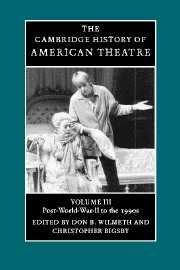Book contents
- Frontmatter
- Introduction
- Timeline: Post-World War II to 1998
- 1 American Theatre in Context: 1945–Present
- 2 A Changing Theatre: Broadway to the Regions
- 3 The Plays and Playwrights
- 4 Musical Theatre since World War II
- 5 Directors and Direction
- 6 Actors and Acting
- 7 American Theatre Design Since 1945
- Bibliography
- Index
Introduction
Published online by Cambridge University Press: 28 March 2008
- Frontmatter
- Introduction
- Timeline: Post-World War II to 1998
- 1 American Theatre in Context: 1945–Present
- 2 A Changing Theatre: Broadway to the Regions
- 3 The Plays and Playwrights
- 4 Musical Theatre since World War II
- 5 Directors and Direction
- 6 Actors and Acting
- 7 American Theatre Design Since 1945
- Bibliography
- Index
Summary
The previous volume of this History told the story of the growth of Broadway theatre, the emergence of major playwrights, the shift from melodrama to a new realism and from that realism to a self-conscious experimentalism. It identified the extent to which the theatre reflected social change, as America moved from a rural to an urban economy, engaged a modernity which both delighted and appalled, and found in social inequity the source of dramatic energy. It charted the continuing influence, on actor training and design no less than dramaturgy, of the European theatre but also identified the extent to which America now exercised a powerful role. Through boom and Depression, the theatre in all its guises – from the Little Theatre movement, to the Federal Theatre, Broadway comedies and musicals, to powerful dramas of social and psychological experience – proved a public art with public appeal.
Yet already that role was threatened by the emergence of Hollywood. Ahead lay television. By the turn of the twenty-first century hundreds of channels would be available while cyberspace would exert its own seductive allure. Meanwhile, the economics of an art which required the collaborative efforts of a large number of people, used its plant inefficiently, and was often inconveniently situated, made it potentially less attractive than other arts or forms of entertainment.
This volume, though, is not an account of decline. Indeed, in some respects it covers a period in which the achievements of the American theatre were acknowledged worldwide as never before. For much of the second half of the century its playwrights were dominant, its musicals defined the genre, its actors, directors, and designers proved uniquely talented and internationally influential.
- Type
- Chapter
- Information
- The Cambridge History of American Theatre , pp. 1 - 20Publisher: Cambridge University PressPrint publication year: 2000
- 1
- Cited by



